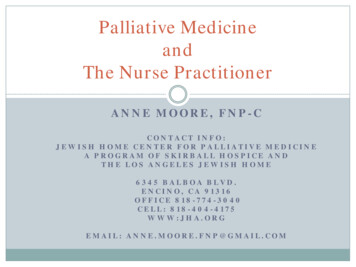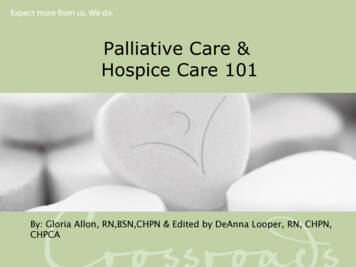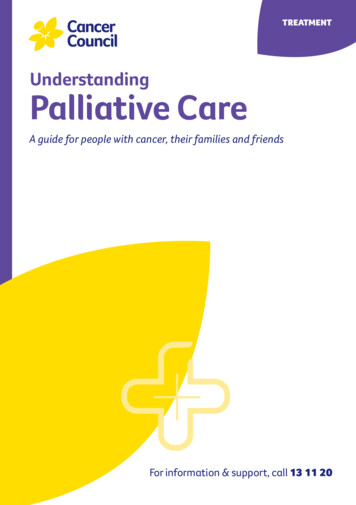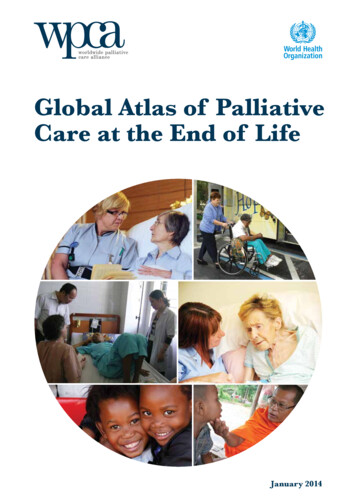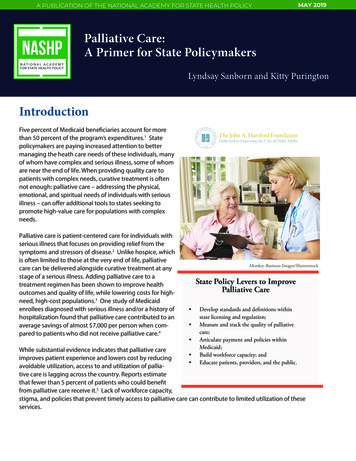
Transcription
A PUBLICATION OF THE NATIONAL ACADEMY FOR STATE HEALTH POLICYMAY 2019Palliative Care:A Primer for State PolicymakersLyndsay Sanborn and Kitty PuringtonIntroductionFive percent of Medicaid beneficiaries account for morethan 50 percent of the program’s expenditures.1 Statepolicymakers are paying increased attention to bettermanaging the heath care needs of these individuals, manyof whom have complex and serious illness, some of whomare near the end of life. When providing quality care topatients with complex needs, curative treatment is oftennot enough: palliative care – addressing the physical,emotional, and spiritual needs of individuals with seriousillness – can offer additional tools to states seeking topromote high-value care for populations with complexneeds.Palliative care is patient-centered care for individuals withserious illness that focuses on providing relief from thesymptoms and stressors of disease.2 Unlike hospice, whichis often limited to those at the very end of life, palliativecare can be delivered alongside curative treatment at anystage of a serious illness. Adding palliative care to atreatment regimen has been shown to improve healthoutcomes and quality of life, while lowering costs for highneed, high-cost populations.3 One study of Medicaidenrollees diagnosed with serious illness and/or a history ofhospitalization found that palliative care contributed to anaverage savings of almost 7,000 per person when compared to patients who did not receive palliative care.4Monkey Business Images/ShutterstockState Policy Levers to ImprovePalliative Care Develop standards and definitions withinstate licensing and regulation;Measure and track the quality of palliativecare;Articulate payment and policies withinMedicaid;Build workforce capacity; andEducate patients, providers, and the public.While substantial evidence indicates that palliative care improves patient experience and lowers cost by reducing avoidable utilization, access to and utilization of palliative care is lagging across the country. Reports estimatethat fewer than 5 percent of patients who could benefitfrom palliative care receive it.5 Lack of workforce capacity,stigma, and policies that prevent timely access to palliative care can contribute to limited utilization of theseservices.
2Palliative Care: A Primer for State PolicymakersIf states employ a range of policy strategies, they can play an important role in improving access to palliativecare and the quality of services delivered. This brief provides resources for state policymakers interested inexpanding palliative care, including: An outline of field-tested definitions and resources;Identification of key policy considerations; andOpportunities available to states to support their palliative care policies and programs.Overview of Palliative Care“Serious illness is any condition that carries ahigh risk of mortality, negatively impacts qualityof life and daily function, and/or is burdensomein symptoms, treatments, or caregiver stress.”Kelley, Amy. (2014). Defining "Serious Illness".Journal of palliative medicine. 17. 10.1089/jpm.2014.0164.Palliative care addresses the “physical, functional,psychological, practical, and spiritual consequences ofa serious illness.”6 It is a team-based, interdisciplinaryapproach that includes services, such as advance care planning, pain management, counseling, carecoordination, and addressing the needs of the family. Importantly, palliative care can be delivered alongsidecurative treatment and does not require an individual to forgo other interventions.7Palliative care can be delivered by health care professionals with varying levels of expertise.8 The NationalAcademy of Medicine defines palliative care as either primary or specialty care: primary palliative care (ornon-specialty palliative care) is provided by health care professionals who may not have specialty trainingor hold a certification in palliative health care. Internists, primary care physicians, nurse practitioners, andoncologists, for instance, may assess and manage symptoms, and provide information, referral, and supportto patients with serious illness and their families. Specialty palliative care providers are trained in complexcare and disease management, which includes the treatment of persistent and progressive symptoms,worsening of anxiety and depression in those with serious illness, end-of-life counseling, and documentingpatient’s goals and desires surrounding the type of care they wish to receive during their illness and death.9Specialty palliative care is delivered by clinicians with advanced training and/or certification, often inconjunction with a multidisciplinary team that can include a nurse, social worker, physician, a chaplain, andother supports.Palliative care can be delivered across a wide range of settings. Hospitals have been at the forefront ofpalliative care delivery: hospital certification was established by The Joint Commission in 2011, and as of2016, 75 percent of hospitals with more than 50 beds provided access to a palliative care team.10 While therehas been a steady increase in the availability of hospital palliative care programs, this increase in capacityvaries across regions and states, with fewer programs in rural, southern states and smaller hospitals.11Research shows that public and private insurance payment for palliative care in hospital settings varies aswell, and may not cover all aspects of care.12Increasingly, palliative care is being delivered in community settings, such as outpatient practices andclinics, homes, and residential care facilities.13 The Joint Commission began certifying community palliativeprograms offered by home health and hospice programs in 2016.14 Clinical Practice Guidelines for QualityPalliative Care, developed by the National Consensus Project, can also provide guidance on palliative caredelivery in community settings.15 Similar to palliative care within hospital settings, payment for palliativecare services delivered outside of the hospital or hospice setting varies widely, depending on payer and otherfactors.16NATIONAL ACADEMY FOR STATE HEALTH POLICY Download this publication at www.nashp.org
Palliative Care: A Primer for State Policymakers3Key Considerations for State PolicymakersAs explored in the National Academy for State Health Policy (NASHP) report, Advancing Palliative Care for Adultswith Serious Illness: A National Review of State Palliative Care Policies and Programs, states have a number ofpolicy levers they can use to improve access to and quality of palliative care. Outlined below are some of the keyconsiderations that state health policymakers may want to explore when crafting and implementing policies thatsupport palliative care.Review how palliative care is defined by state policies and programs. The National Quality Forum identified fivestructural elements of high-value palliative care models. These models: Target services to the highest risk group;Include an interdisciplinary team of providers and social supports;Provide 24/7 access to clinical care;Integrate medical and social supports; andProvide services alongside and independent from curative care.NASHP identified that approximately 50 percent of states define palliative care in some way, and/or incorporatestandards for palliative care in regulation.18 That said, how and where palliative care is defined matters – moststates define palliative care within the context of hospice licensure or regulation, limiting the applicability ofdefinitions or standards to services provided to those with a terminal illness. States can consider tying definitionsand standards to a wider range of facilities and providers positioned to deliver this level of care. Colorado broadlydefines palliative care within its health care facility licensing regulations to include team-based, specializedcare for people with serious illness, with the goal of providing relief from symptoms regardless of diagnosis.The definition applies to services delivered within hospitals and nursing facilities.19 Maryland defines palliativecare in its hospital regulations and provides standards for palliative care service delivery that include staffing,education, and plan of care requirements.20Measure the quality of palliative care services. The National Quality Forum’s (NQF) portfolio for Palliative and Endof-Life Care includes measures that address the physical and social aspects of care, including pain management,dyspnea, and the spiritual, psychological, cultural, and legal aspects of care.21 Five states, Colorado, Illinois,New York, Rhode Island and Texas, include palliative care-related quality metrics in their financial alignmentdemonstrations or Medicaid managed care long-term services and supports contracts. Texas’ Delivery SystemReform Incentive Payment (DSRIP) program has several health care transformation projects that include palliativecare quality improvement. Texas DSRIP providers can elect to report on eight palliative care metrics to earnincentives.22Identify populations that can benefit most from palliative care services. For specialty palliative cares services,state Medicaid programs can identify populations that may benefit most from these services to help increaseaccess and target scarce resources. States can identify priority populations based on factors such as functionality,diagnosis, or level of acuity. California’s Medicaid program, Medi-Cal, designed its palliative care benefit toaddress the needs of individuals with congestive heart failure, chronic obstructive pulmonary disease, advancedcancer, and liver disease. Use of claims and clinical data can assist states in identifying patients who could benefitmost from palliative care services. States can also consider bolstering access to palliative care in settings thatserve complex patients, such as post-acute rehabilitation and skilled nursing facilities.Leverage continuing medical education requirements to build workforce capacity and increase access. Access topalliative care can be limited due to a lack of trained providers, especially in rural or smaller hospitals.23 States areincreasingly including palliative care as a continuing medical education (CME) requirement, building capacity tomanage lower-acuity patients in primary care or non-specialist practices. Rhode Island physicians are required toNATIONAL ACADEMY FOR STATE HEALTH POLICY Download this publication at www.nashp.org
Palliative Care: A Primer for State Policymakers4complete a minimum of four hours of CME every two years on priority topics identified by the Rhode IslandDepartment of Health, which has included end-of-life and palliative care.24 Under its Medical Practice Act,Vermont requires physicians to have at least one qualifying hour of CME credits demonstrating competencein identifying and referring patients to hospice, palliative care, and pain management services in eachrenewal period.25Articulate policies and payment to support palliative care. State Medicaid programs can pay for certainpalliative care services using existing Current Procedural Terminology (CPT) or Healthcare CommonProcedure Coding System (HCPCS) codes. However, states note that without using modifiers, existingCPT codes may not provide sufficient data to track utilization or evaluate the quality of services delivered.Moreover, states find that simply making the codes available does not necessarily improve access or uptakeof the service.26 Additional outreach and education to providers may be helpful. California developed apalliative care policy that outlined eligibility and available services within the state’s managed care contracts.For fee-for-service (FFS) additional guidance included a description of how services mapped to specificbilling codes within the state’s existing fee schedule.27Consider incorporating palliative care into public health and public education strategies. Stigma surroundingserious illness and end of life can limit public awareness about the benefits of palliative care and inhibit useof services. States can invest in public education efforts to address these barriers. In Wisconsin, the Divisionof Public Health works with the state’s Aging and Disability Resource Centers to educate older adults andindividuals with developmental or intellectual disabilities about palliative care and hospice.28Looking Forward: State Palliative Care PolicyOpportunitiesNASHP research into state palliative care policies found that most states are just beginning to explore howpalliative care can support existing health reform efforts. Certain state health policies and programs may be ofparticular interest as states explore the value of these services: Home and Community-Based Services (HCBS) benefits: State Medicaid HCBS waivers are designed tosupport individuals with complex needs to live in the community and avoid more costly institutional levelsof care. Both primary and specialty palliative care services align well with their emphasis on person-centeredplanning required by recent changes to HCBS regulations.Medicaid managed care contracts for complex populations: States are increasingly contracting withmanaged care organizations to oversee Medicaid long-term services and supports benefits. Incorporatingpalliative care service definitions and/or measures into managed care contract language offers states anopportunity to target these services to populations with complex and serious illnesses. Similarly, MedicareDual Eligible Special Needs Plans (D-SNPs) are required to contract with states and serve some of Medicaid’smost complex and highest-cost beneficiaries. These contracts may provide another policy lever for stateswanting to target palliative care to higher-need Medicaid beneficiaries.Delivery system reforms: States have made significant investments in patient-centered medical homes,health homes for individuals with chronic conditions, collaborative care, and other models that supportteam-based, person-centered, and coordinated care. States may want to explore how this existinginfrastructure can be leveraged to educate providers, enhance access to primary palliative care, and facilitatereferral to specialty services when needed.Opioid prescribing limits: State legislative and regulatory initiatives that establish limitations on opioidprescribing can have the unintended consequence of limiting necessary and critical medications for peoplereceiving palliative care. Many states have taken steps to mitigate this unintended consequence by carvingout prescribing exceptions for palliative care from these prescribing limitations.NATIONAL ACADEMY FOR STATE HEALTH POLICY Download this publication at www.nashp.org
Palliative Care: A Primer for State Policymakers5ConclusionPalliative care is good care, a person-centered approach that can ease the burden of disease for individuals withserious illness while reducing avoidable spending. The approach aligns well with states’ interests in supportingvalue-driven care, particularly for individuals with complex needs. Recent research suggests that states are justbeginning to explore how palliative can support other state health reform goals and initiatives. As more peoplelive longer with complex, serious conditions, approaches to care that support the quality of life – while honoringindividual needs and preferences – will become increasingly important. For more information and resources tosupport states in these efforts, visit NASHP’s Palliative Care .18.19.20.21.22.23.24.25.Medicaid: A Small Share of Enrollees Consistently Accounted for a Large Share of Expenditures, Report to Congressional Requesters, United States GovernmentAccountability Office, May 2015, https://www.gao.gov/assets/680/670112.pdfAbout Palliative Care, Center to Advance Palliative Care, Accessed on April 16, 2019, a Smith, et al., “Evidence on the cost and cost-effectiveness of palliative care: A literature review,” Palliative Medicine 28, no. 2 (July 2013): 130-150.R. Sean Morrison, et al., “Palliative Care Consultation Teams Cut Hospital Costs For Medicaid Beneficiaries,” Health Affairs 30, no. 3 (Mar. 2011).Kumar, P., Casarett, D., Corcoran, A., Desai, K., Li, Q., Chen, J., Mao, J. J. (2012). Utilization of supportive and palliative care services among oncology outpatientsat one academic cancer center: determinants of use and barriers to access. Journal of palliative medicine, 15(8), 923–930. doi:10.1089/jpm.2011.0217 35/National Voluntary Consensus Standards for Palliative Care and End-of-Life Care, National Quality Forum, Accessed on April 6,2019 https://www.qualityforum.org/Projects/Palliative Care and End-of-Life Care.aspxMellar P. Davis, et al., “A review of the trials which examine early integration of outpatient and home palliative care for patients with serious illnesses,” Annals ofPalliative Medicine 4, no. 3 (July 2015).Clinical Practice Guidelines for Quality Palliative Care, 4th Edition, National Consensus Project for Quality Palliative Care, Accessed on April6, 2019, loads/2018/10/NCHPC-NCPGuidelines 4thED web FINAL.pdfDying in America: Improving Quality and Honoring Individual Preferences Near the End of Life, Institute of Medicine of the National Academies, ReleasedSeptember 14, 2015. h of Palliative Care in U.S. Hospitals 2016 Snapshot, New York: Center to Advance Palliative Care, 2018.R. Sean Morrison and Diane E. Meier, America’s Care of Serious Illness: 2015 State-by-State Report Card on Access to Palliative Care in our Nation’s Hospitals (NewYork, NY: Center to Advance Palliative Care, 2015).Sullender RT, Selenich SA. Financial Considerations of Hospital-Based Palliative Care [Internet]. Research Triangle Park (NC): RTI Press; 2016 Mar.Available from:https://www.ncbi.nlm.nih.gov/books/NBK532652/ doi: 10.3768/rtipress.2016.rr.0027.1603Palliative Care in the Outpatient Setting A Comparative Effectiveness Report Revised Draft Report. Institute for Clinical and Economic Review, published on March9, 2016, mmunity-Based Palliative Care Certification Option for Home Health & Hospice, The Joint Commission, Accessed on April 16, 2019, https://www.jointcommission.org/community-based palliative care certification option july 1 2016/Clinical Practice Guidelines for Quality Palliative Care, 4th Edition, National Consensus Project for Quality Palliative Care, Accessed on April6, 2019, loads/2018/10/NCHPC-NCPGuidelines 4thED web FINAL.pdfWhy Some Patients Aren’t Getting Palliative Care, The Pew Charitable Trust, July 10, 2017, t-getting-palliative-careNational Voluntary Consensus Standards for Palliative Care and End-of-Life Care, National Quality Forum, Accessed on April 6, 2019, https://www.qualityforum.org/Projects/Palliative Care and End-of-Life Care.aspxRachel Donlon, Kitty Purington, Natalie Williams, Advancing Palliative Care for Adults with Serious Illness: A National Review of State Palliative Care Policies andPrograms, National academy for State Health Policy, Published December 2018, ative-Care-Brief-Final.pdf#6 Colorado Code of Regulations 1011-1 Chap 02. ?ruleVersionId 5623&fileName 6%20CCR%201011-1%20Chap%2002Code of Maryland Regulations (COMAR) 10.07.01.01.Palliative and End-of-Life Care 2015-2016 Technical Report, National Quality Forum , December 23, 2016, Palliative and End-of-Life Care 2015-2016.aspxTexas DSRIP Measure Bundle Protocol, Texas Department of Health and Human Services, June 6, 2017, l.pdfR. Sean Morrison and Diane E. Meier, America’s Care of Serious Illness: 2015 State-by-State Report Card on Access to Palliative Care in our Nation’s Hospitals (NewYork, NY: Center to Advance Palliative Care, 2015).216-RICR-40-05-1.5.5; and State of Rhode Island Department of Health, “Physician Licensing,” accessed December 6, 2018. http://health.ri.gov/licenses/detail.php?id 200/.Vermont Department of Health Board of Medical Practice, “Rule of the Board of Medical Practice,” effective October 15, 2017. http://www.healthvermont.gov/sites/NATIONAL ACADEMY FOR STATE HEALTH POLICY Download this publication at www.nashp.org
Palliative Care: A Primer for State Policymakersdefault/files/documents/pdf/BMP Board%20Rules%20Effective%202017.pdf.26. State-Only Roundtable: State Strategies to Address Palliative Care, Facilitated Conversation, National Academy for State health Policy Annual Conference,August 16, 2018.27. Letter to All Managed health Care Plans, Re: Palliative Care, State of California, Health and Human Services Agency Department of Health Care Services,Dec.7, 2018, DAPLsandPolicyLetters/APL2018/APL18-020.pdf28. Wisconsin Department of Health Services Division of Public Health, Aging and Disability Resource Center Grant Agreement, January 1, 2018-December 31,2018. fservicesfinal.pdf.Acknowledgements:The National Academy for State Health Policy (NASHP) wishes to thank Stacie Sinclair at the Center to Advance Palliative Care, Rachel Donlon,and Trish Riley for their input and additions to this brief. The authors also wish to thank Amy Berman, Scott Bane, and Rani Snyder of The JohnA. Hartford Foundation for their input and generous support of this work. This state scan was supported by a grant from The John A. HartfordFoundation.About the National Academy for State Health Policy:The National Academy for State Health Policy (NASHP) is an independent academy of state health policymakers working together to identifyemerging issues, develop policy solutions, and improve state health policy and practice. As a non-profit, nonpartisan organization dedicated tohelping states achieve excellence in health policy and practice, NASHP provides a forum on critical health issues across branches and agencies ofstate government. NASHP resources are available at: www.nashp.org.6
Palliative care can be delivered across a wide range of settings. Hospitals have been at the forefront of palliative care delivery: hospital certification was established by The Joint Commission in 2011, and as of . 2016, 75 percent of hospitals with more than 50 beds provided access to a palliative care team. 10. While there

